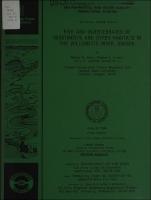Please use this identifier to cite or link to this item:
https://hdl.handle.net/11681/4540Full metadata record
| DC Field | Value | Language |
|---|---|---|
| dc.contributor | Oregon Cooperative Fishery Research Unit | - |
| dc.contributor | Environmental and Water Quality Operational Studies (U.S.) | - |
| dc.contributor.author | Hjort, Randy C. | - |
| dc.contributor.author | Hulett, Patrick L. | - |
| dc.contributor.author | LaBolle, Larry D. | - |
| dc.contributor.author | Li, Hiram W. | - |
| dc.date.accessioned | 2016-03-16T22:09:59Z | - |
| dc.date.available | 2016-03-16T22:09:59Z | - |
| dc.date.issued | 1984-08 | - |
| dc.identifier.uri | http://hdl.handle.net/11681/4540 | - |
| dc.description | Technical Report | - |
| dc.description | Abstract: In this study, physical and biological parameters were compared at revetments and other aquatic habitats in the Willamette River below Salem, Oregon. The purpose was to determine if revetments affect the distribution and abundance of fishes and invertebrates, and to examine relationships between the physical parameters and the biological community. Sampling sites included two revetments, two natural banks, two side channels, and an abandoned channel. The study was conducted in 1982 at two flow levels. Sampling periods were June when flows were moderate (283-425 m³/sec) and August when flows were low (221-238 m³/sec). The physical parameters included water quality indices (temperature, dissolved oxygen, pH, redox potential, turbidity, and conductivity), water velocity, and sediment analysis . The biological parameters were fish and invertebrate densities and fish weight. During each study period, water quality indices were similar at all stations except for those in the abandoned channel, which was generally higher in water temperatures and conductivities and more variable in dissolved oxygen. Water temperatures and turbidities were higher during the August sampling period compared to June. Water current velocities were highest at the natural bank sites followed by the revetments and secondary channels . The abandoned channel had little or no water flowing through it. Bottom types included large rocks at the revetments, silt and gravel mix in the abandoned channel, coarse gravel or sand at Five Island natural bank and the secondary channels depending on the water velocity, and silt and clay at Candiani natural bank where there was a severe erosion problem. The species compositions of fishes and invertebrates were different among the habitats. Squawfish were the most abundant fish at the revetments and at Five Island secondary channel. Largescale suckers were the most abundant at Candiani natural bank, Candiani secondary channel, and the abandoned channel, and leopard dace were the most abundant at Five Island natural bank. Anisogammarus was the most abundant invertebrate at the revetments, while Oligochaetes were the most abundant at Candiani natural bank, Five Island secondary channel, and the abandoned channel. Chironomids were the most abundant invertebrate at Five Island natural bank and Candiani secondary channel. The densities of fish and invertebrates were generally highest at the revetments. The densities of fish were lowest in the secondary channels, and the densities of invertebrates were lowest at Candiani natural bank. The number of species and the species diversity were similar among the sampling sites. The total fish weight was highest at the abandoned channel, followed by Candiani secondary channel, Candiani natural bank, and the revetments. Characteristics of the revetments include higher densities of fish and invertebrates; however, the species compositions at the revetments were different than those at the other habitats. Revetments offer stability of substrate and protective cover for organisms during high flows. | - |
| dc.publisher | Environmental Laboratory (U.S.) | - |
| dc.publisher | Engineer Research and Development Center (U.S.) | - |
| dc.relation | http://acwc.sdp.sirsi.net/client/en_US/search/asset/1036821 | - |
| dc.rights | Approved for public release; distribution is unlimited. | - |
| dc.source | This Digital Resource was created from scans of the Print Resource | - |
| dc.subject | Willamette River | - |
| dc.subject | Oregon | - |
| dc.subject | Aquatic ecology | - |
| dc.subject | Fish | - |
| dc.subject | Fishes | - |
| dc.subject | Invertebrates | - |
| dc.subject | Hydraulic structures | - |
| dc.subject | Environmental aspects | - |
| dc.subject | Environmental effects | - |
| dc.subject | Revetments | - |
| dc.subject | Environmental management | - |
| dc.title | Fish and invertebrates of revetments and other habitats in the Willamette River, Oregon | - |
| dc.type | Report | en_US |
| Appears in Collections: | Technical Report | |
Files in This Item:
| File | Description | Size | Format | |
|---|---|---|---|---|
| TR-E-84-9.pdf | 18.76 MB | Adobe PDF |  View/Open |